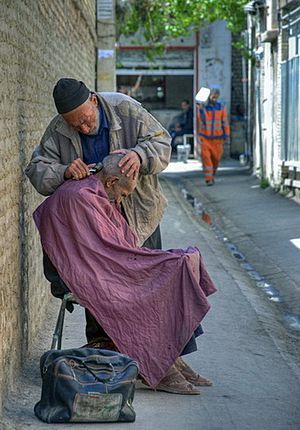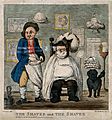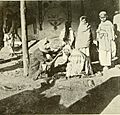Barber facts for kids
A barber is a person who cuts and styles hair, especially for men. They also often shave or trim beards. While women usually go to hairdressers, barbers mainly serve male clients. You might recognize a barber shop by its special pole outside, which is usually red and white. Barbering is a very old and respected job with a fascinating history!
Contents
What Barbers Do
The main job of a barber is to cut and style a client's hair to make it look good and fit their wishes. Barbers also shape and trim beards and mustaches. They need to keep their tools, like scissors and combs, very clean and in good condition. Barbers are also responsible for keeping their shop tidy, like sweeping up hair.
If a barber owns their shop, they also order supplies, pay bills, and might hire other staff. To be a good barber, it's important to be friendly and have a positive attitude, as you'll be talking to many different people every day.
With experience, barbers can become managers of a salon or barber shop. Some even open their own businesses! It's also possible to teach others how to become barbers. In some places, the rules for barbers and cosmetologists (people who do hair, makeup, and skin care) are combined.
Barber Words and Names
Today, the word "barber" is used for professionals who specialize in men's hair. But a long time ago, all people who styled hair were called barbers. Later, the job of cosmetology became separate. Now, hairdressers can be licensed as either barbers or cosmetologists.
The exact rules and names can be different depending on where you live. For example, in some places, only barbers are allowed to use a straight razor for shaving. In other places, both barbers and cosmetologists can use them.
In Australia, the official term for a barber is hairdresser. The word barber is still used, but it's more of a popular nickname for men's hairdressers. Most barbers there work in a hairdressing salon.
History of Barbers

The job of a barber is very old! Tools like razors have been found from the Bronze Age (about 3500 BC) in ancient Egypt. In those times, barbers were highly respected. Priests and healers were some of the first barbers.
In early tribes, barbers were very important because people believed that evil spirits could enter a person's body through their hair. Cutting hair was thought to be a way to get rid of these spirits. Because of these beliefs, barbers even performed religious ceremonies like marriages and baptisms!
In Ancient Greece, men would get their beards, hair, and fingernails trimmed by a koureus in a public place called an agora. This place was also where people gathered to talk and share news.

Barbering came to Rome from Greek colonies in Sicily in 296 BC. Barber shops quickly became popular places for daily news and gossip. For young Roman men, their first shave (called tonsura) was a big part of becoming an adult.
Some Roman barbers became rich and famous, running popular shops for important people. But most were simple workers who had small shops or worked on the streets for low prices.

During the Middle Ages, barbers often did more than just cut hair and shave. They also acted as surgeons and dentists! Besides hair services, "barber surgeons" would perform small surgeries, bloodletting (removing blood), fire cupping, enemas, and even pull out teeth. The famous barber pole, with its red and white stripes, showed these two jobs: red for surgery and white for barbering.
Barbering Today
The way people get their hair cut has changed over time. A barber named Sam Mature, who was interviewed in a book called Working, said that men used to get haircuts every couple of weeks. But now, many people wait a month or two, or even longer. This is partly because long hair became popular. Older generations often wanted to look very neat and tidy, but today, styles are more varied.
Images for kids
-
"The Barber at the Souk" by Enrique Simonet, 1897
-
Barber at Peshawar, British India, 1907
-
Barbershop in Bucharest around 2016. Men find the lost comradery between their peers, inside such "new traditional" barbershops, a revival of the old ones.
See also
 In Spanish: Barbero para niños
In Spanish: Barbero para niños











